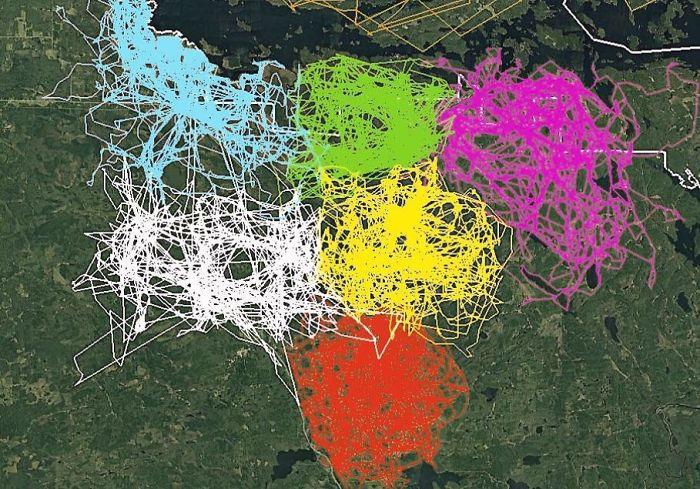GPS Tracking Map of Wolves in Voyageurs National Park


Marcus Rodriguez
Historical Geography Expert
Marcus Rodriguez specializes in historical cartography and geographic data analysis. With a background in both history and geography, he brings unique...
Geographic Analysis
What This Map Shows
This GPS tracking map visualizes the movements of multiple wolves across six different packs in and around Voyageurs National Park, Minnesota. The map captures the dynamic range of these fascinating creatures as they traverse their habitat, providing insights into their behavior, territory, and interactions. By following the paths of these wolves, we can better understand their ecological roles and the environmental factors that influence their survival.
Deep Dive into Wolf Populations in Minnesota
Wolves are a keystone species in many ecosystems, and their presence plays a critical role in maintaining the balance of their environments. In Minnesota, the gray wolf (Canis lupus) is the most prominent species, with an estimated population of around 2,000 individuals. These wolves are often found in packs, which typically consist of a family unit led by a dominant breeding pair. Interestingly, the pack structure allows wolves to work collaboratively when hunting, raising pups, and defending their territory.
The GPS data on this map reveals significant details about the hunting grounds and territorial ranges of each pack. Wolves generally require large territories—often spanning from 20 to over 100 square miles—depending on the availability of prey and other environmental factors. For example, a pack residing in an area with abundant deer will have a smaller territory than one in a less favorable landscape.
What’s fascinating is how these wolves adapt their movements in response to seasonal changes. During warmer months, they may roam more widely to hunt for food, while in winter, they tend to stay closer to their dens, especially when caring for pups. This behavioral pattern is crucial for understanding the wolves' ecological needs and how they adapt to their environment over time.
Moreover, the GPS tracking technology allows researchers to observe wolves' interactions with their environment. For instance, data may show that certain packs avoid human activity or agricultural areas, highlighting their instinctual behavior to steer clear of potential threats. This information is vital for conservation efforts, as it helps identify critical habitats that need protection.
Regional Analysis
Voyageurs National Park, located in northern Minnesota, is a unique landscape characterized by its vast lakes, wetlands, and boreal forests. The map divides the tracking data into six distinct packs, each exhibiting unique movement patterns based on their respective territories. For instance, one pack might predominantly inhabit the eastern section of the park, where dense forests provide ample cover, while another might favor the western side, closer to the lakes where prey is more abundant.
Comparing these packs reveals interesting differences in their hunting strategies. The pack that primarily roams near water bodies may have adapted to hunt aquatic prey, such as beavers, while another pack in forested areas relies more heavily on deer. Such variations illustrate the adaptability of wolves and their ability to thrive in diverse habitats. Additionally, the movement patterns can indicate how packs overlap and compete for resources, which is a natural aspect of their social structure.
Significance and Impact
Understanding the GPS tracking of wolves in Voyageurs National Park is crucial for several reasons. Firstly, it aids in the conservation of these magnificent animals, allowing wildlife managers to make informed decisions about habitat protection and population management. Furthermore, studying wolf behavior helps illuminate the broader ecological dynamics at play in Minnesota's wilderness. For instance, the presence of wolves can regulate deer populations, which in turn affects vegetation and overall ecosystem health.
Current trends indicate that while wolf populations in Minnesota are stable, they are still vulnerable to habitat loss and human encroachment. As development increases around the park, it is vital to monitor how these changes impact wolf movements and pack dynamics. Future projections suggest that maintaining connectivity between habitats will be essential for the long-term survival of wolves and other wildlife. By promoting conservation initiatives and protecting critical habitats, we can help ensure that these remarkable creatures continue to thrive in Minnesota’s beautiful landscapes.
In conclusion, the GPS tracking map of wolves in Voyageurs National Park offers a window into the complex lives of these animals. By examining their movements and behaviors, we not only learn about wolves but also about the health of the ecosystems they inhabit. What’s your take on the importance of tracking and studying wildlife? Have you considered how these efforts contribute to conservation and biodiversity?
Visualization Details
- Published
- August 18, 2025
- Views
- 118
Comments
Loading comments...